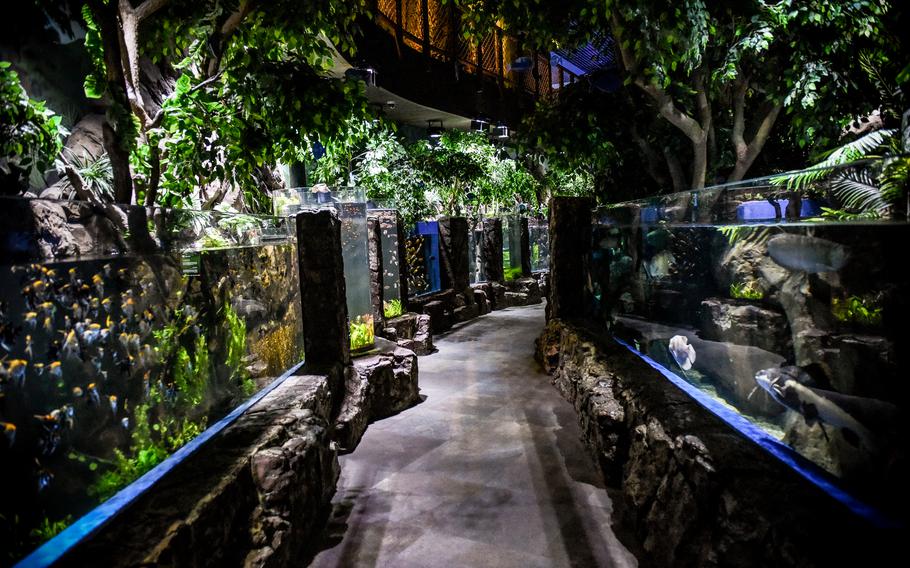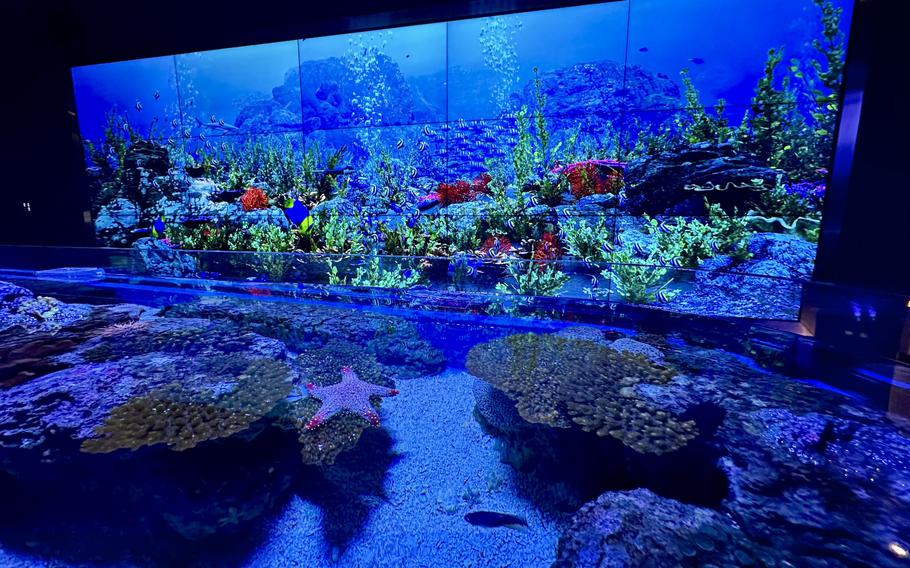
The entrance to the Rainforest Habitat, one of three immersive zones at the Marassi Aquarium, features dense greenery and freshwater tanks. This section houses large, prehistoric fish species and leads to the deeper Ocean Trench habitat. (Shannon Renfroe/Stars and Stripes)
Bahrain summers don’t bring along the dry desert heat others assured me I’d experience here.
You don’t just move through the island kingdom’s air in August; you wear it. Even respites like pool decks heat flip-flops to grill temperatures.
Finding something to do that didn’t involve mall shopping was a challenge. Then someone mentioned that a new aquarium had opened inside one of those very malls.
It sounded like a gimmick. I was reminded of a zoo I visited in another country, where an exhibit included house cats. So I wasn’t expecting much, maybe a few goldfish and a tired Nemo or two.
The entrance on the third floor of the high-end Marassi Mall stood out, with an immersive archway covered in vibrant coral reef and marine elements.
The aquarium is divided into different marine environments. Beside each tank, digital screens cycle through details about the fish inside. The information adds depth to the experience, reinforcing that the aquarium was built to inform and engage.
I even watched two divers suit up and slip into the trench habitat to make what looked like minor tank repairs. It was a relief that someone was actively caring for this world behind the glass.
Before reaching the exhibitions, a series of smaller aquariums line the hallway. There were longhorn cowfish drifting near coral, lionfish with striped fins moving slowly in place and moray eels tucked in rock crevices, only their heads visible.
Moorish idols swam in small groups, their black, white and yellow bodies easy to spot. These tanks allow time to notice the details and quirks of fish most people would never otherwise see.

The starfish pond at the Marassi Aquarium introduces visitors to tidepool ecosystems, highlighting the role of sea stars in marine biodiversity. Informational screens nearby explain their anatomy, feeding behavior and regenerative abilities. (Shannon Renfroe/Stars and Stripes)
The Rainforest Lagoon shifted the tone entirely. The fish were massive and looked more like the prehistoric ancestors of the others I’d seen.
A pale, thick-bodied fish hovered near the glass with a blank, almost terrified stare. A gar with a crocodilian snout and scales like armor drifted just below the surface. An arowana glided by with metallic stealth, and a monstrous catfish hugged the floor, its long whiskers fanned out like antennae.
The arapaima fish’s scales can deflect piranha bites and its teeth are the stuff of nightmares. As it was being fed, the water’s surface exploded with thrashing. I genuinely worried for the feeder’s hand.
Some of the fish seemed off. Not physically, but emotionally, if fish can even feel that way. A neon orange anthias, a species known to thrive in large schools, swam in a tank with other fish that weren’t her kind in the same short loop, a vivid hot-pink square on its side like a misplaced label.
Another fish nestled deep in a rock crevice, unmoving. Maybe I was projecting, or maybe that’s just the cost of safety. A friend who once built aquariums explained that many of these animals wouldn’t survive in the wild.
Aquariums, he said, protect what’s endangered, offering shelter, breeding programs and public education as a kind of insurance against extinction. Conservation depends on captivity. But maybe freedom and protection have always been two distinct kinds of survival.
Still, there was an absolute calm here I hadn’t expected. The low lighting, the movement, the animals — all of it pulled me out of the heat and my mundane concerns.
There are studies showing that aquariums can lower heart rate and reduce stress. A 1999 Purdue University report even found that aquariums improved eating habits and behavior in Alzheimer’s patients.
I went in skeptical, expecting a mall mildness. I left thinking about the intelligence of other species, what it means to frame nature behind glass in the name of preservation and how much I still don’t know. I learned about creatures I’d never heard of before.
I kept thinking about a hybrid-looking ray from the Ocean Trench habitat. I’ll probably think about it for the rest of my life. It was so deliberately still and it held my gaze, following me as I walked to the other side of the tank. Was it a coincidence or did I catch a flicker of awareness? It made me stop and reconsider how we define connection.
I wasn’t the only one pulled in. Families moved from tank to tank, kids glued to the glass, pointing, squealing, asking a hundred questions. There’s something about the way sea life holds attention.
If you go, aim for a weekday, when it’s quieter and easier to take your time. I’d bypass the onsite cafe in favor of the full lineup of mall options that offer better value.
And unless you’re set on spending extra for the “ultimate pass,” the standard admission provides plenty of access. It’s surprisingly worth the stop — even if all you meant to do at the mall was grab a new pair of pants.
Marassi Aquarium Address: Marassi Galleria Mall, Shop No. 4068, Bldg. 166, Road 264, Block 264, Bahrain Hours: Saturday through Wednesday, 10 a.m.-10 p.m.; Thursday through Friday, 10 a.m.-11 p.m. Prices: Regular pass, 6 dinars ($16); ultimate pass, 9 dinars ; annual pass, 20 dinars Information: @marassiaquariumbahrain on Instagram